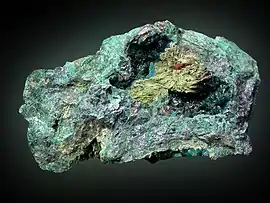Demesmaekerite
Demesmaekerite is a rare uranium selenite mineral with the chemical formula: Pb2Cu5(UO2)2(SeO3)6(OH)6·2H2O.
| Demesmaekerite | |
|---|---|
 A specimen of demesmaekerite associated with blue chalcomenite crystals | |
| General | |
| Category | Oxide mineral |
| Formula (repeating unit) | Pb2Cu5(UO2)2(SeO3)6(OH)6·2H2O |
| Strunz classification | 4.JJ.20 |
| Crystal system | Triclinic |
| Crystal class | Pinacoidal (1) (same H-M symbol) |
| Space group | P1 |
| Unit cell | a = 11.94 Å, b = 10.02 Å, c = 5.62 Å; α = 90°, β = 100°, γ = 91.91° |
| Identification | |
| Color | Green to olive green - turns brownish on dehydration |
| Crystal habit | Elongated, striated, typically in radial aggregates |
| Mohs scale hardness | 3-4 |
| Diaphaneity | Translucent to opaque |
| Specific gravity | 5.28 |
| Optical properties | Biaxial (+) |
| Refractive index | nα = 1.835 nγ = 1.910 |
| Pleochroism | Yellow green to brown |
| Dispersion | Strong |
| Other characteristics | |
| References | [1][2] |
It is named after the Belgian mineralogist Gaston Demesmaeker, who worked at the Musonoi Mine in Katanga.[1] It is a secondary mineral which contains lead, copper and selenium, it is a bottle green to brown/yellow color, its crystal habit varies depending on where it is found.
It can be found associated with other rare selenium-bearing uranium ores, such as haynesite, guilleminite, marthozite and piretite.[2]
This article is issued from Wikipedia. The text is licensed under Creative Commons - Attribution - Sharealike. Additional terms may apply for the media files.